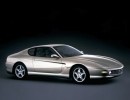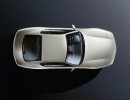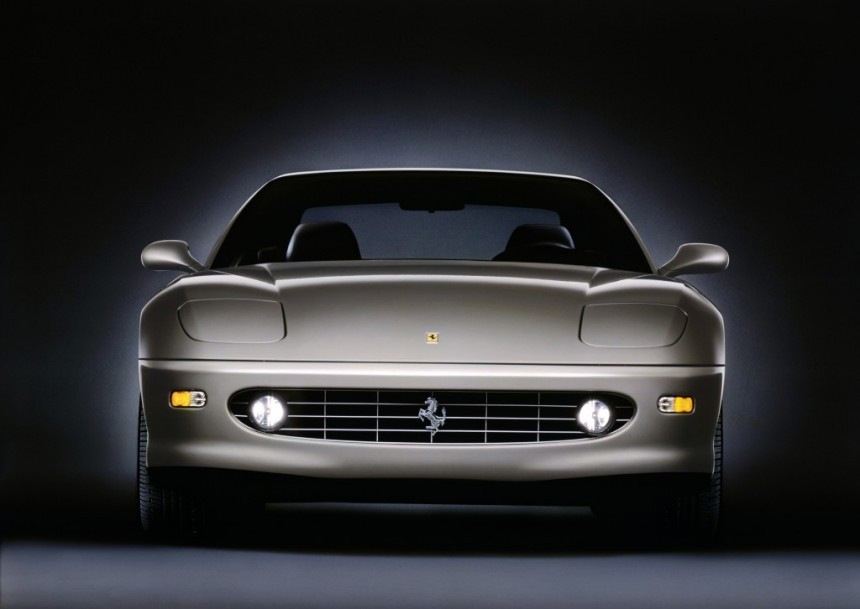Manufactured between 1947 and 1989, the V12 designed by Gioacchino Colombo was replaced by a brand-new powerplant in 1992. Greatly inspired by the Dino V6 and V8 engine families, the first application of the F116 is the grand tourer we’re going to cover today, the fabulous 456.
Initially presented at the FF40 event in 1992, where the Prancing Horse of Maranello celebrated its Belgian distributor Garage Francorchamps, the 456 GT was then publicly revealed at the Paris Motor Show in October 1992.
Preceded by the 412 series and many other four-seat Fezzas that trace their roots back to the 250 GTE from 1959, the V12-engined cruiser was penned by Pininfarina designer Pietro Camardella who also worked on the F40.
Slotted above the 348 and Mondial t but under the 512 TR, the 456 features a tubular spaceframe rather than a pressed steel monocoque like the 348. Named as such after the displacement of each cylinder in cubic centimeters, the family-sized Ferrari is further gifted with aluminum body panels welded to the chassis with the help of Feran. Essentially a strip of steel clad with aluminum on one or both sides, Feran is also utilized to make heat shields, engine mountings, and household appliances such as microwave ovens.
Fitted with coil springs over gas-filled shock absorbers and wishbones, the suspension system of the 456 further includes unequal length wishbones, anti-roll bars, and a self-leveling rear axle. Servotronic power steering, anti-lock brakes with ventilated rotors all around, and 17-inch wheels fitted with Pirelli tires also need to be mentioned, along with a 110-liter fuel tank.
Until the 1996 Geneva Motor Show, the graceful 456 could be had exclusively with a transaxle manual transmission, Ferrari’s first six-speed manual to be more precise. Following the Swiss motor show, a four-speed automatic was added to the options list. Developed by Ricardo and based on the 4T80E introduced by GM in 1993, the slushbox sold 1,053 units in total.
By comparison, the manual-equipped 456 GT and 456M GT moved 2,236 examples worldwide. Being a torque-converter design based on the Turbo-Hydramatic 125 transmission family, the automatic was two-tenths of a second slower to 100 kilometers per hour (62 miles per hour) at 5.4 seconds versus 5.2 seconds for the row-your-own gearbox with a gated shifter.
Faster on the Fiorano circuit than the 512 TR, the 456 GT features the F116 engine that was originally rated at 436 horsepower and 406 pound-feet (550 Nm) of torque. The 65-degree V angle of the 5.5-liter mill is shared with the V6 of the Dino 246 and Lancia Stratos, whereas the 88-millimeter bore and 75-millimeter stroke are shared with the V8 motor of the 348.
Not offered in the United States of America until the summer of 1994 due to stringent emission regulations, the 456 was upgraded in 1995 with airbags that were standard in U.S. cars and optional in other markets. This year also marks the switch from a three- to a four-spoke steering wheel.
Tipping the scales at 1,690 kilograms (3,726 pounds), the 456 can reach 186 miles per hour (300 kilometers per hour) on full song. By comparison, the succeeding 612 Scaglietti from 2004 weighs in at 1,850 kilograms (4,079 pounds) and maxes out at 320 kilometers per hour (199 miles per hour).
An extremely clean design that doesn’t feature in-your-face aero bits and one-too-many air vents like the 812 Competizione, the 456 was mildly updated in 1998 to create the 456M. The so-called Modificata is easy to distinguish from the 456 via the smaller grille with two round fog lights.
As far as famous owners are concerned, the final Ferrari with pop-up headlights was much to the liking of Michael Schumacher, who used to own a 456M GT with custom goodies from the Carrozzeria Scaglietti Program.
Hassanal Bolkiah, a.k.a. the Sultan of Brunei, had at least three four-door sedans and two convertibles built by Pininfarina. The Italian coachbuilder also delivered six wagons, née Venice, to Prince Jefri Bolkiah of Brunei.
Over its 11-year run, Ferrari sold 3,289 units of the 456 series.
Preceded by the 412 series and many other four-seat Fezzas that trace their roots back to the 250 GTE from 1959, the V12-engined cruiser was penned by Pininfarina designer Pietro Camardella who also worked on the F40.
Slotted above the 348 and Mondial t but under the 512 TR, the 456 features a tubular spaceframe rather than a pressed steel monocoque like the 348. Named as such after the displacement of each cylinder in cubic centimeters, the family-sized Ferrari is further gifted with aluminum body panels welded to the chassis with the help of Feran. Essentially a strip of steel clad with aluminum on one or both sides, Feran is also utilized to make heat shields, engine mountings, and household appliances such as microwave ovens.
Fitted with coil springs over gas-filled shock absorbers and wishbones, the suspension system of the 456 further includes unequal length wishbones, anti-roll bars, and a self-leveling rear axle. Servotronic power steering, anti-lock brakes with ventilated rotors all around, and 17-inch wheels fitted with Pirelli tires also need to be mentioned, along with a 110-liter fuel tank.
Until the 1996 Geneva Motor Show, the graceful 456 could be had exclusively with a transaxle manual transmission, Ferrari’s first six-speed manual to be more precise. Following the Swiss motor show, a four-speed automatic was added to the options list. Developed by Ricardo and based on the 4T80E introduced by GM in 1993, the slushbox sold 1,053 units in total.
Faster on the Fiorano circuit than the 512 TR, the 456 GT features the F116 engine that was originally rated at 436 horsepower and 406 pound-feet (550 Nm) of torque. The 65-degree V angle of the 5.5-liter mill is shared with the V6 of the Dino 246 and Lancia Stratos, whereas the 88-millimeter bore and 75-millimeter stroke are shared with the V8 motor of the 348.
Not offered in the United States of America until the summer of 1994 due to stringent emission regulations, the 456 was upgraded in 1995 with airbags that were standard in U.S. cars and optional in other markets. This year also marks the switch from a three- to a four-spoke steering wheel.
Tipping the scales at 1,690 kilograms (3,726 pounds), the 456 can reach 186 miles per hour (300 kilometers per hour) on full song. By comparison, the succeeding 612 Scaglietti from 2004 weighs in at 1,850 kilograms (4,079 pounds) and maxes out at 320 kilometers per hour (199 miles per hour).
An extremely clean design that doesn’t feature in-your-face aero bits and one-too-many air vents like the 812 Competizione, the 456 was mildly updated in 1998 to create the 456M. The so-called Modificata is easy to distinguish from the 456 via the smaller grille with two round fog lights.
As far as famous owners are concerned, the final Ferrari with pop-up headlights was much to the liking of Michael Schumacher, who used to own a 456M GT with custom goodies from the Carrozzeria Scaglietti Program.
Hassanal Bolkiah, a.k.a. the Sultan of Brunei, had at least three four-door sedans and two convertibles built by Pininfarina. The Italian coachbuilder also delivered six wagons, née Venice, to Prince Jefri Bolkiah of Brunei.
Over its 11-year run, Ferrari sold 3,289 units of the 456 series.




















